Select File | Load Data | Greyscale Image.
Use the History button to select the image loaded most recently.
Step through the rest of the wizard, as descibed in Section 2.
This section gives step by step instructions on segmenting an image using the region competition snake (in last section's terminology, snake evolution that uses the region feature image). This section assumes that you are working with the image MRIcrop-orig.gipl, as recommended in Section 2, Step 1. We will segment the caudate nucleus and the ventricles in this image. This section also assumes that you are using the label file MRIcrop-seg.label.
You can, however, follow the general directions of this section using a different image, but you will have to use your own judgement in selecting various parameters.
In Section 4, we have created a manual segmentation. In order to perform the segmentation automatically, we will discard the manual segmetnation. This involves reloading the greyscale image.
|
Select File | Load Data | Greyscale Image. Use the History button to select the image loaded most recently. Step through the rest of the wizard, as descibed in Section 2. |
We will be segmenting the caudate nucleus. We have to make sure that the appropriate combination of the current drawing label and background (draw over) label is selected.
|
Make sure that the label "caudates" is selected as the current drawing label Make sure that "All Labels" is selected in the Draw over drop-down box. |

|
The draw over label functions the same way in automatic segmentation as in manual segmentation. It lets you apply the results of automatic segmentation to all labels, to all visible labels, to the clear label, or to a particular label. This gives you a lot of creative control when segmenting multiple structures. For instance, to segment a structure that is embedded inside another structure, you can first segment the outer structure with label A and then segment the inner structure with label B and with the draw-over label set to A. |
The automatic segmentation component of SNAP requires a lot of computer resources. Both the amount of memory and the time required to compete a segmentation can be reduces by selecting a sub-region of the image on which to perform segmentation. In this step, we will select a subregion of the image that contains the caudate nucleus.
|
Make sure that the slice is fully visible in each the slice windows by pressing the Reset View buttons underneath the slice windows. |
|
Select the snake tool in the IRIS toolbox (shown below) |

As you select the snake tool, a pink-colored dashed selection box will appear at the border of the each slice in the slice windows, as shown below:
 |
 |
The selection box displays the region of interest that will be used in automatic segmentation. The use of word region here should not be confused with region competition. The region of interest is a rectalinear box, while the regions in region competition are of arbitrary shape and are defined by uniform intensity. We will now adjust the region of interest by dragging the sides of the selection box
|
In one of the slices position the mouse cursor near one of the corners of the selection box Hold down the left mouse button and drag the mouse towards the center of the image. The size of the box will be adjusted as you move the mouse. |
As you are dragging the selection box, its edges change color from red to yellow.
|
Using all three slice windows, adjust the selection box to include the left and right caudate nuclei. Try to simulate the selection box in the picture below. |
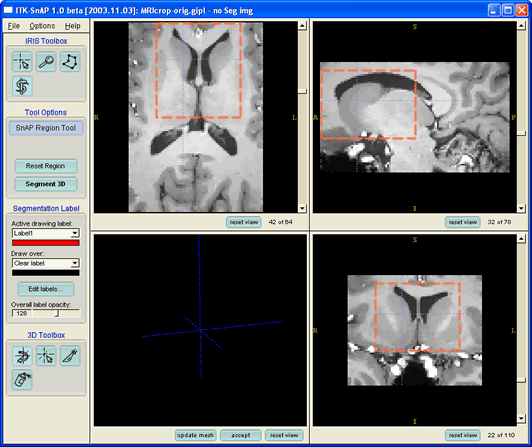
|
If the selection box disappears in one of the slice windows, that means that the crosshairs position is outside of the selection box. You can adjust the crosshairs position in one of the adjacent slices. The crosshair position can be adjusted in this mode using the left mouse button as usual. However, you will need to click a few pixels away from the selection box to move the crosshairs. |
Notice that the tool options control subpanel contains two buttons: Reset Region and Segment 3D. The former is used to reset the region of interest to the entire image. The second is used to enter the automatic segmentaiton mode of SNAP.
|
Once you have adjusted the region of interest, press the Segment 3D button. |
When you press the Segment 3D button, the SnAP user interface changes considerably.
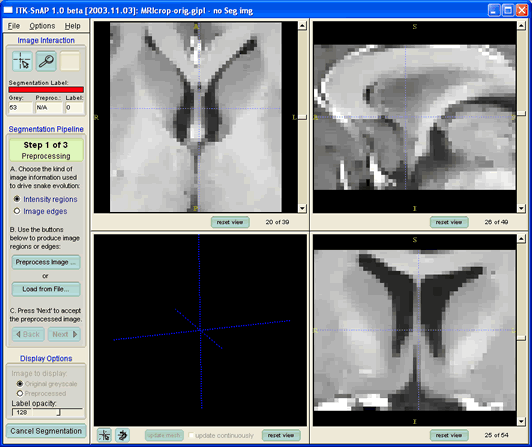
Let's look at some of the new elements that have appeared:
|
If the image slices appear washed out, i.e., have low contrast, use the Intensity Curve window to change the contrast as described in Section 3. |
Recall the concept of edge and region competition feature images from the last section.In this step we will construct a region competition feature image appropriate for segmenting the caudate nuclei.
First let's tell SnAP which type of the feature image we will be using:
|
Select the option Intensity Regions in the section A of the Segmentation Pipeline Wizard. |
Now, let's estimate the range of intensities to which the voxels in the caudate nucleus belong.
|
Move the crosshairs around the caudate nuclei. Look at the values of the grey level intensity, which is reported in a box labeled "Grey" underneath the toolbar. |
You will find that the intensities in the caudate range between the high 40's and low 60's. This information is improtant for contructing the feature image.
|
Press the button labeled Preprocess Image... This button is used to construct the feature image. The following window will appear |
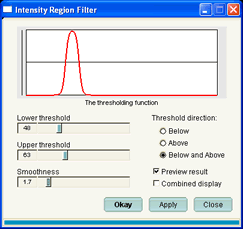
This window is used to specify the mapping between the greyscale image intensities and the values of the feature image, which fall into the range between -1 and 1.
|
In the Intensity Region Filter window
|
|
After you use the mouse to click on and move the knobs that are used to change the threshold and smoothness values, you can use the left and right arrow keys to move these knobs one value at a time. |
As soon as you change some of the parameters, the SnAP slice windows will display the feature image instead of the grey image. As you change the parameters, the slice windows are updated immideately. If you uncheck the Preview result checkbox, the slice windows will only reflect the values of the parameters when you press the Apply button.
Our goal in setting the parameters is to make sure that the voxels inside of fthe caudate nuclei are assigned positive values in the feature image, and that the voxels outside of it are assigned negative values. There are two ways to check that this happens:
| Move the crosshairs around in the slice windows (the intensity region filter window will remain on top). Look at the values of the feature image, which are reported in a box labeled "Preproc" underneath the toolbar. |
or
|
Check the Combined Display check box. The greylevel image is shown again, but the pixels where the feature image is positive are painted over with the color of the current segmentation label, as shown below. This is an easy way to make sure that the pixels in the caudate have a positive feature image value. Uncheck Combined Display check box to see the feature image again. |
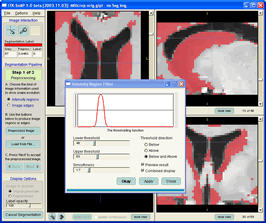
The smoothness value determines the steepness of the mapping curve. It does not affect the sign of the feature function at any particular voxel, but it does have an effect on the smoothness of the snake evolution.
| When you are satisfied with the feature image, press Okay to compute the feature image at all voxels and close the intensity region filter window. |
|
SnAP lets you save and load feature images. Just use the appropriate menu items in the File menu. You can also load feature images by pressing the Load from File... button in the segmentation pipeline wizard. |
|
Voxels in feature images are saved as floating point numbers, so some applications may not be able to load the saved images. You can not save feature images in GIPL format because if does not support floating point voxels. The Meta format is recommended. |
We are now almost done with the first step of the Segmentation Pipeline Wizard.
| Press the Next button in the Segmentation Pipeline Wizard to proceed to the next step. |
The Segmentation Pipeline Wizard should be displaying "Step 2 od 3", as shown below.
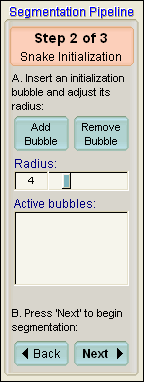
This step of the wizard is used to position spherical bubbles to that initialize the snake, as described in the previous section.
|
Move the crosshairs such that the crosshairs position is inside of the right caudate nucleus in all three slice windows. Press the Add Bubble button to place a bubble at the crosshairs position. Use the Radius slider to change the radius of the bubble. |
After adding a bubble, the SnAP window should look like this:
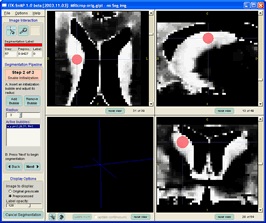
|
Place one more bubble inside the right caudate and place two bubbles inside the left caudate. |
The result should look something like this:

|
To remove a bubble, select it in the list of bubbles underneath the Radius slider and press the Remove bubble button. |
Finally,
| Press the Next button in the Segmentation Pipeline Wizard to proceed to the next step. |
|
As an alternative to using bubbles, you can use manual segmentation to initialize the snake. Before starting automatic segmentation, create a manual segmentation as described in Section 4 using the same label that you wish to use for snake segmentation. The manual segmentation will be used as the snake initialization, and you would not have to add any bubbles. |
The Segmentation Pipeline Wizard should be displaying "Step 3 od 3", as shown below.

This wizard page allows you to set the parameters for snake evolution, and it allows you to control the snake using VCR-style controls.
|
Press Set Parameters... to open the snake parameter window. |
The Snake Parameters window is shown below. This window consists of two parts. On the left is a control panel used to specify various parameters, mainly the weights of the propagation, curvature, and advection forces that were discussed in Section 5. These velocities are displayed using a fixed feature image, and not the feature image that you are working with. Nevertheless, this image is useful for understanding the relative contribution of the forces to snake evolution
|
The red curve for which the velocities are shown can be changed using the mouse. Left-click once in one of the four windows showing the curve and yellow 'control points' will appear. Move the control points by dragging using with the left mouse button. Try moving the curve and see how the foces change. |
The snake parameter window also lets you save snake evolution parameter settings to a file and to load them from a file.

|
Change the curvature velocity weight to from 0.20 to 0.15 Press Accept to close the window |
|
The Mathematical Mode tab of the Snake Parameters Window shows mathematical expression for the partial differential equation that drives the snake evolution, and allows you to set the parameters directly as constants in this equation. You can also choose to display the experimental equation, which contains more terms and gives you more control over snake evolution. |
|
The Advanced Mode tab of the Snake Parameters Window is discussed in the section on Tips and Tricks. It can be used to speed up large segmentations. |
Now that we've set the snake parameters, we are ready to run the snake evolution. Notice the VCR-style controls located in the Segmentation Pipeline Wizard.

These controls have the following functionality:
Underneath the VCR buttons is a control that allows you to set the size of the step used in snake evolution. The larger the step value, the fewer times will the user interface be updated as the snake evolves. For small segmentations, it is advisable to leave the step size at 1. Next to the step size dropbox is a display that shows the current iteration.
|
Press the Step button several times to run the snake for a few iterations Press the Run button once and watch the snake fill up the caudates. Press the Stop button when the caudates have been filled up Press the Rewind button if you want to restart. |
To see the segmentation result in 3D, you can press the Update Mesh button underneath the 3D window, or you can select the Update Continuously checkbox.
|
Warning! Selecting Update Continuously will degrade segmentation performace significantly, possibly by orders of magnitude! |
The result of the segmentation should look something like this.
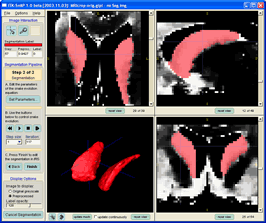
The final step in the automatic segmentation process is to return to the SNAP manual segmentation mode, incorporating the segmentation results with other structures that have been previously segmented.
|
Press the Finish button in the Segmentation Pipeline Wizard |
The Segmentation Pipeline Wizard will disappear, and the layout of the SNAP control panel will return to normal.
|
[Optional] Save your segmentation as described in Section 4. |
In this step we will postprocess the results of the segmentation using 3D tools.
|
Press the Update Mesh button below the 3D window to render the results |
Now, let us examine the different tools available in the 3D Toolbox, which is shown below.
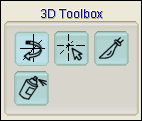
The toolbox contains four tools. Top to bottom, left to right, they are
Let's begin by examining the 3D trackball tool:
|
Select the 3D Trackball Tool Press and hold the left mouse button and move the mouse to rotate the 3D view. Press and hold the right mouse button and move the mouse up or down to zoom in and out in the 3D view Press and hold the middle mouse button and move the mouse to pan in the 3D view. |
Now try the 3D crosshair tool:
|
Select the 3D Crosshair Tool Position the mouse over any point on the caudates and click the left mouse button. The crosshair position will move to the selected point and the slices shown in the slice windows will be changed. |
Now, something more complex. We will use the 3D scalpel tool to assign different labels to the left and right caudate nuclei.
|
Use the Edit Labels button to add two new labels called 'left caudate' and 'right caudate' with different colors (for information on editing labels, see Section 3). |
|
Select 'right caudate' as the current drawing label, and select 'caudates' (the label used for automatic segmentation) as the label to draw over, as shown below. |

The 3D scalpel tool works by partitioning the space into two regions separated by a plane. The segmentation labels on one side of the plane are replaced by the current drawing label, as long as they agree with the current setting of the draw over label. In order to use the scalpel tool, we need to first rotate the 3D view such that a line can be drawn between the two caudates.
|
Use the 3D Trackball tool to rotate the 3D view in such a way that the caudates can be separated by an imaginary line, as shown below. |

Now, we will use the 3D scalpel tool to actually draw a line in place of the imaginary line
|
Select the 3D Scalpel Tool Click the left mouse button at one end of the imaginary line separating the caudates Move the mouse around the 3D window. You will see a white line indicating where the 'cut' will be made, and an arrow indicating which half of the space will be relabeled. Click the left mouse button again at the other end of the imaginary line |
The result of this operation should look like this:

|
If you are not satisfied with the 'cut', press the Reset View button and try again. |
|
Otherwise, press the Accept button to repaint one of the caudates with the active drawing label and press the Update Mesh to see the result in 3D. |
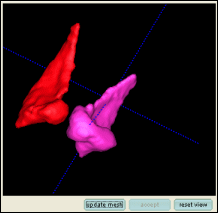
The 3D scalpel is a very powerful tool for editing segmentation results. Using the clear label as the active drawing label, you can erase parts of the segmentation that have leaked outside of the caudates.
|
Use the procedure outlined in the steps above to segment the ventricles in the image. You will need to use the Above threshold direction setting when creating the feature image. |

The result should look like this
